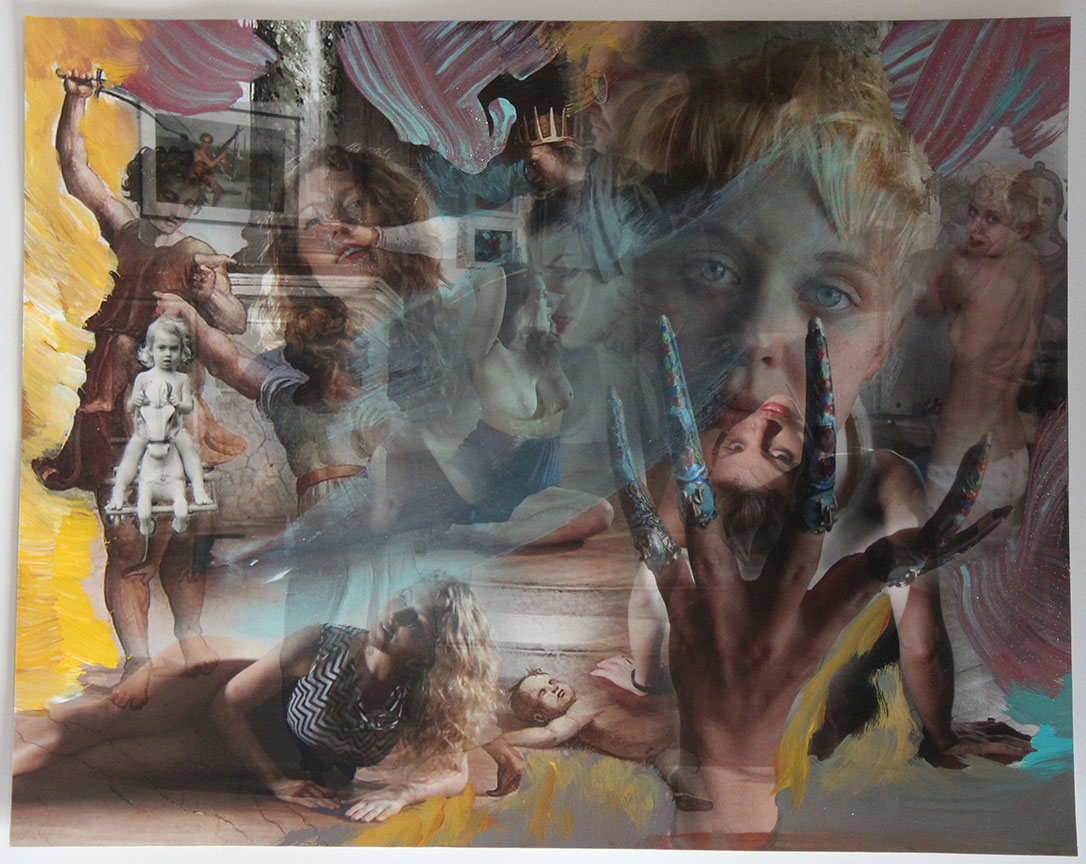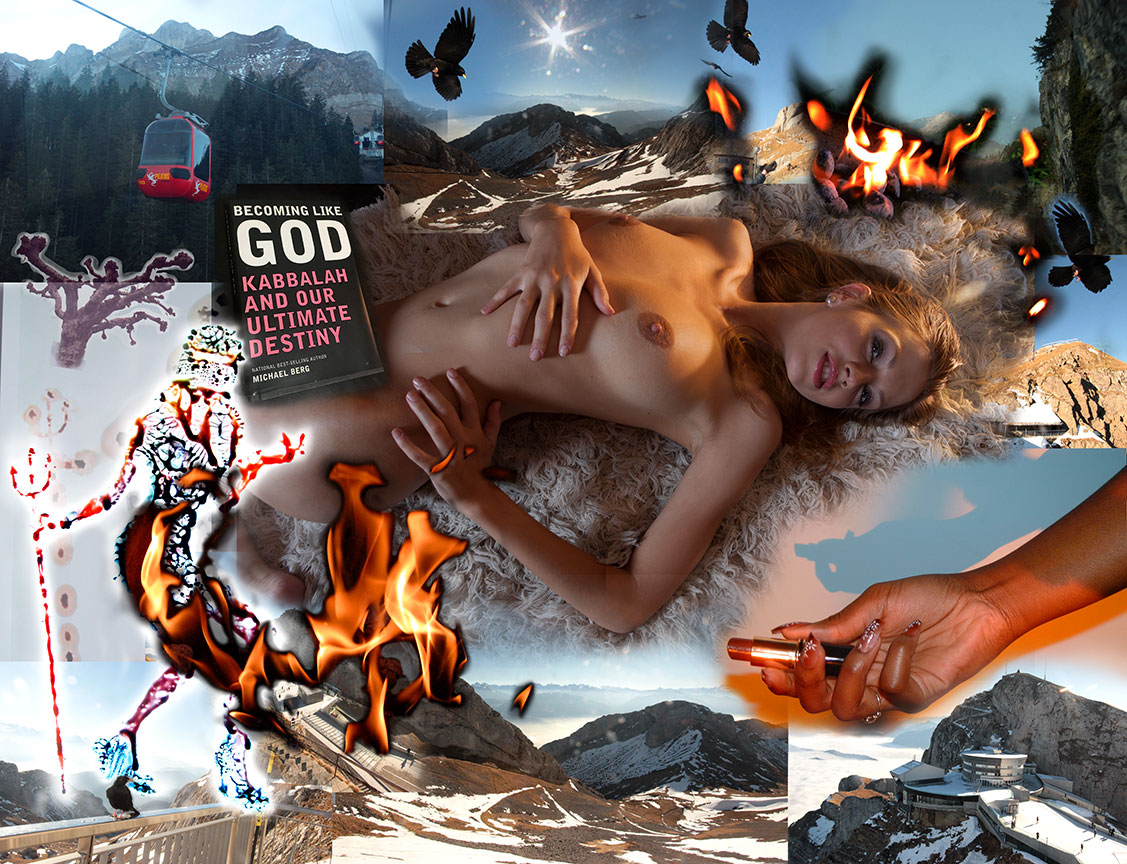"There are 2 main forces that set the stage for our actions upon this earth: Love and Fear.
With Love, we set our goals. With fear, we set our boundaries.
Rafael Fuchs new exhibition of mixed-media works , titled: “Biblical Tales" is an organic continuation of his “LandLords” exhibition from 2014.
This time, he is expanding in creating mixed-media works by adding to his palette oil and acrylic paints as well as other objects that he’s attaching to his archival prints on canvas.
Are robotic drones the new angels that bring us the “truth” and force the future as the angels and prophets did during the Biblical times?
Is worshiping a Golden Calf in the Bible times similar to glorifying flesh and vanity in our modern society ?
How did Esther become a pragmatic radical rhetoric model ?
Was Sodom and Gomorrah just a hedonistic city the embraced homosexuality, or were they really evil ?
How could David the King continue reining after he committed murder and adultery crimes?
How did Solomon used the the basic human instinct as the evidence for truth ?
Can a human become like God ?
These are a few of the questions and issues that Rafael Fuchs is dealing with in his new body of mixed-media works, titled” Biblical Tales"
“While growing up as a kid in Israel...studying the Bible was a part of the curriculum of the elementary school.
I have been always fascinated by the stories and myth that the Old Testament is offering, although I grew up nonorthodox.
In these epic stories there is magic, drama, glory, envy and cruelty all combined.”- R.F.
His works give the viewer "a glimpse into the human subconscious, where fears of pressure and responsibility give rise to stubborn obsessions”
He is transforming them, and combining them, visually, with his own experiences, conflicts, doubts and obsessions, as well with the current social and political climate that penetrates and influences the work as well.
In the story of “The Golden Calf”, Fuchs gives a new interpretation to the false idol and presents it as an image of a contemporary beautiful woman in an alluding pose to a classic greek pose. Modern-day drones are replacing the biblical angels, and the contemporary Chassidic men and their sons are surrounding the idol, although not interacting directly with it.
Is this looming figure a symbol for the masses current preferences, or is it a false idol we should reject ?
What is the power of women these days, and what is the right representation of women at this moment ?
In the Biblical tale Moses went to Mount Sinai to obtain the ten Commandments from God and bring it to those people that were recently freed from slavery in Egypt, who were waiting impatiently in the desert for 40 days for him to descend back.
They are in a state of fear and uncertainty that brings the obsession and demand of a dominant figure who will protect and provide mental, moral and physical security . So, in the Bible, they melted their golden jewelry, and created a Golden Calf to worship.
"In the new version of the Golden Calf, I am reflecting my own fascination and obsession, as well as commenting on the trend of the masses ?” -R.
The series of painting of “Lot’s Wife” from the Sodom and Gomorrah story have an “explosion of colors” that goes with the chaotic and brutal end of the story. Sodom and Gomorrah have been used as metaphors for vice and homosexuality that were viewed as a deviation and were completely consumed by fire and brimstone.
Was the punishment way too harsh ? Were it just two progressive-hedonistic cities whose citizens went too far in the eyes of God ?
As in a few other works, Rafael Fuchs is using also images that he picks from the internet and adds them to his own main images that he photographed, as references and narratives to the stories he derives from.
In his process he starts, sometimes, with a main image , and the biblical story is built around it.
As an artist, I have to keep my art true to myself, and the visual stories are a my personal interpretations, expressing my amazement with those epic stories and my own conflicts, doubts and desires. These has common threads with the lives of the Orthodox people as well.” -R.F.
In “The Story of Esther”, you can see also Native-Americans (a diorama that was photographed by Rafael in a North Dakota museum)
According to Susan Zaeske, the story of Esther is a "rhetoric of exile and empowerment that, for millennia, has notably shaped the discourse of marginalized peoples such as Jews, women, African Americans.” Zaeske argues that Esther speaks not only for women but for a multi-gender oppressed group and does it in such a way that “depicts rhetorical dynamics, not only of Jews living in a foreign court, but also of women coping in a society intensely hostile to their gender.” In this way, Esther’s rhetoric has been interpreted not as strictly feminist rhetoric or strictly Jewish rhetoric but rhetoric of intersectional exiled or marginalized groups.[
Esther is portrayed in the work revealing herself, although the Biblical story at the Purim Megillah starts with Vashti the Queen, refusing to reveal herself and entertain the King’s guests, and therefore she was replaced by Esther as his new wife.
“I started with the image of “Esther” , and built around it. The wild horses came since I was looking for some images that represent power, energy that is storming towards the revealing model, and then Native American diorama (which I shot at the same time that I was in North Dakota) came along.
Only after I decided to use the image of me as a young boy during Purim (wearing a costume of a king) , it became “The Story of Esther.”
In another work, “The Annotation of David The King” ("portrayed by a woman whose expression conveys a state of euphoria and non-belief of sorts to what’s happening around") Fuchs is using some references to the inauguration of Trump, who had the “Lord Of The Dance” group as entertainers during his inauguration festivities.
In another work, “The story of Bat Sheba" is expressed with a nude figure that is hovering over a roof (of the new Whitney Museum)
It’s, actually, the story of David's sins of adultery and murder.
He was the second king of the United Kingdom of Israel and Judah, reigning in c. 1010–970 BC
Bat Sheba was summoned by him after he had seen her bathing on her roof and lusted after her.
He sent her husband to a war where it was obvious that he would be killed, in order for David to gain her.
He was punished later, on a few circumstances, on for his sins.
"A lot, if not most, of the wars and violence between human beings nowadays are a result of belief differences, mostly religions differences.
My role, if I am designated to any, is to evoke our responsibilities as human beings to each other, by trying to understand ourselves better, our motives and our aspirations, and by trying to understand each other better.
I am trying to explore and look at those ancient tales in a new, contemporary and personal way and make the connections, analogies and parralels to what is happening in our world today, to our own anxieties, miseries, desires, fears, ambitions and necessities.
I believe that most of us think and see it a similar way. Most people tend to forget that we all have the ability and we are allowed to re-think , re-focus and look at things from a different perspective.My role is to pick those thoughts and elevate them to a visible expression. To ask the same question that we all ask ourselves and each other,with the attempt to live in a better harmony with ourselves, others and nature.The future of humanity is impacted by nature as well by the progress in technology, but it’s more affected by how we react to each other.
I find it interesting and fulfilling to draw a line from the present to the past and find what’s the common thread between us and the ancient Israelites…either simple people, kings, prophets or even sinners. I am interested to find and understand the connection between myself and the viewers and these people that we know of by reading the bible.
"I see myself as someone who is spreading the Jewish tradition in a positive and visually enticing way , although some of the orthodox Jews might not accept this style of visual story telling that I provide.
But, as an artist, I have to keep my art true to myself, and the visual stories are a my personal interpretations, expressing my amazement with those epic stories and my own conflicts, doubts and desires. These has common threads with the lives of the Orthodox people as well.”
Those who wrote the bible , told the tales, manipulated and embellished the reality, added fantasy and mystery (some people wouldn’t agree with this statement) wanted to leave a mark and relay a message to the future generations. I am continuing this ambition based on my own personal views, experiences, mind and soul.” _R.F.




























